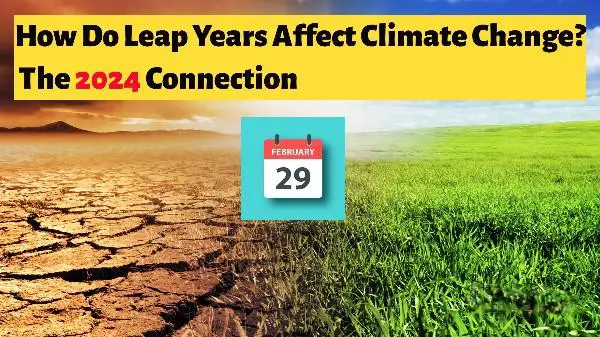Leap years, which mark an extra one day during February, often spark interest as to their relation to larger phenomena such as climate change. While their relationship may not always be obvious, leap years reveal the intricate interplay between Earth’s rhythms and environmental issues we are currently facing. By looking deeper, we can discover subtle but profound effects from leap years on climate as well as how they relate to current discussions about environmental sustainability by 2024.

Understanding Leap Years
A leap year arises from Earth’s orbit around the sun, which takes approximately 365.2422 days. To ensure our calendar remains aligned with astronomy and changing seasons, an additional day — February 29th –is added every four years as part of an adjustment mechanism. Otherwise, timekeeping would become disconnected with natural cycles, leading to human timekeeping being unsynchronized from natural cycles.
Climate Change: A Complex Reality
As it is essential to recognize, leap years do not directly have an effect on climate. Instead, they result from complex causes driven by human activities, most significantly greenhouse gas releases, such as carbon dioxide production in the atmosphere accelerating global warming which in turn has far-reaching repercussions like weather disruptions, rising sea levels and disruptions to ecosystems.
Subtle Impacts of Leap Years on Climate

As leap years don’t directly contribute to climate change, they still exert subtle influences that affect Earth’s climate dynamics:
- Weather Patterns: An extra day added in February can have subtle but lasting impacts on short-term weather patterns. While these changes might not fundamentally shift climate trends, they could show up as minor fluctuations in temperature or precipitation reflecting atmospheric dynamics and their intricate processes.
- Seasonal Shifts: Leap years serve as an effective reminder of Earth’s imperfect orbit and of seasonal variations caused by our changing climate, creating challenges to agricultural practices, biodiversity conservation and ecosystem resilience.
- Global Awareness: In addition to their significance as a calendar leap years can provide the opportunity to increase awareness of the intricate ecosystems on Earth and the necessity of environmentally responsible stewardship. A leap year in 2024 is a great an ideal opportunity to participate in discussions about mitigation strategies to combat climate change and to encourage collective action toward sustainable development.
Navigating the Path Forward
As we negotiate the intersection of leap years, and the nexus of climate change 2024, proactive actions are vital to deal with the environmental issues facing our planet:
- Reduce Greenhouse gas emissions: Adopting alternative energy resources, improving efficiency in energy use, and promoting for sustainable transportation are crucial steps to reduce greenhouse gas emissions while also reducing the negative effects of climate change.
- Promoting Change: Keeping in mind the urgent need for climate action by promoting robust environmental policies and making corporations and governments accountable are essential to creating a sustainable future for the generations to follow.
- Accepting Conscious Choices: Adopting the concept of environmental consciousness involves embracing the concepts of reducing, reusing and recycling by making environmentally-friendly choices in your consumer behaviour, and instilling a comprehensive ethos of sustainability in everyday life.
In the intricate web of Earth’s rhythms in time leap years serve as powerful reminders of the planet’s resilience and vulnerability climate changes. In the midst of the realities of climate change in 2024, the interplay of leap year and sustainability emphasizes the need for taking collective action and being stewards of the planet towards protecting our planet for the coming generations. In response to this message to action, we can create the path to an environmentally sustainable and peaceful relationship with the natural world.
Porsha Williams Reveals the Heartbreaking Reason She Ended Her Marriage After Only 15 Months



